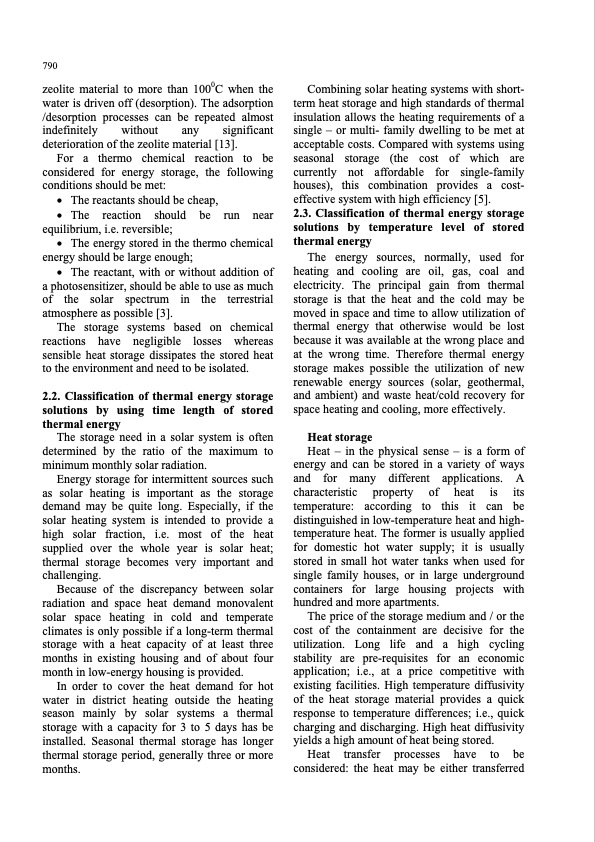
PDF Publication Title:
Text from PDF Page: 007
790 zeolite material to more than 1000C when the water is driven off (desorption). The adsorption /desorption processes can be repeated almost indefinitely without any significant deterioration of the zeolite material [13]. For a thermo chemical reaction to be considered for energy storage, the following conditions should be met: • The reactants should be cheap, • The reaction should be run near equilibrium, i.e. reversible; • The energy stored in the thermo chemical energy should be large enough; • The reactant, with or without addition of a photosensitizer, should be able to use as much of the solar spectrum in the terrestrial atmosphere as possible [3]. The storage systems based on chemical reactions have negligible losses whereas sensible heat storage dissipates the stored heat to the environment and need to be isolated. 2.2. Classification of thermal energy storage solutions by using time length of stored thermal energy The storage need in a solar system is often determined by the ratio of the maximum to minimum monthly solar radiation. Energy storage for intermittent sources such as solar heating is important as the storage demand may be quite long. Especially, if the solar heating system is intended to provide a high solar fraction, i.e. most of the heat supplied over the whole year is solar heat; thermal storage becomes very important and challenging. Because of the discrepancy between solar radiation and space heat demand monovalent solar space heating in cold and temperate climates is only possible if a long-term thermal storage with a heat capacity of at least three months in existing housing and of about four month in low-energy housing is provided. In order to cover the heat demand for hot water in district heating outside the heating season mainly by solar systems a thermal storage with a capacity for 3 to 5 days has be installed. Seasonal thermal storage has longer thermal storage period, generally three or more months. Combining solar heating systems with short- term heat storage and high standards of thermal insulation allows the heating requirements of a single – or multi- family dwelling to be met at acceptable costs. Compared with systems using seasonal storage (the cost of which are currently not affordable for single-family houses), this combination provides a cost- effective system with high efficiency [5]. 2.3. Classification of thermal energy storage solutions by temperature level of stored thermal energy The energy sources, normally, used for heating and cooling are oil, gas, coal and electricity. The principal gain from thermal storage is that the heat and the cold may be moved in space and time to allow utilization of thermal energy that otherwise would be lost because it was available at the wrong place and at the wrong time. Therefore thermal energy storage makes possible the utilization of new renewable energy sources (solar, geothermal, and ambient) and waste heat/cold recovery for space heating and cooling, more effectively. Heat storage Heat – in the physical sense – is a form of energy and can be stored in a variety of ways and for many different applications. A characteristic property of heat is its temperature: according to this it can be distinguished in low-temperature heat and high- temperature heat. The former is usually applied for domestic hot water supply; it is usually stored in small hot water tanks when used for single family houses, or in large underground containers for large housing projects with hundred and more apartments. The price of the storage medium and / or the cost of the containment are decisive for the utilization. Long life and a high cycling stability are pre-requisites for an economic application; i.e., at a price competitive with existing facilities. High temperature diffusivity of the heat storage material provides a quick response to temperature differences; i.e., quick charging and discharging. High heat diffusivity yields a high amount of heat being stored. Heat transfer processes have to be considered: the heat may be either transferredPDF Image | Thermal energy storage overview

PDF Search Title:
Thermal energy storage overviewOriginal File Name Searched:
ThermalEnergyStorage-AnOverview.pdfDIY PDF Search: Google It | Yahoo | Bing
Turbine and System Plans CAD CAM: Special for this month, any plans are $10,000 for complete Cad/Cam blueprints. License is for one build. Try before you buy a production license. More Info
Waste Heat Power Technology: Organic Rankine Cycle uses waste heat to make electricity, shaft horsepower and cooling. More Info
All Turbine and System Products: Infinity Turbine ORD systems, turbine generator sets, build plans and more to use your waste heat from 30C to 100C. More Info
CO2 Phase Change Demonstrator: CO2 goes supercritical at 30 C. This is a experimental platform which you can use to demonstrate phase change with low heat. Includes integration area for small CO2 turbine, static generator, and more. This can also be used for a GTL Gas to Liquids experimental platform. More Info
Introducing the Infinity Turbine Products Infinity Turbine develops and builds systems for making power from waste heat. It also is working on innovative strategies for storing, making, and deploying energy. More Info
Need Strategy? Use our Consulting and analyst services Infinity Turbine LLC is pleased to announce its consulting and analyst services. We have worked in the renewable energy industry as a researcher, developing sales and markets, along with may inventions and innovations. More Info
Made in USA with Global Energy Millennial Web Engine These pages were made with the Global Energy Web PDF Engine using Filemaker (Claris) software.
Sand Battery Sand and Paraffin for TES Thermo Energy Storage More Info
| CONTACT TEL: 608-238-6001 Email: greg@infinityturbine.com | RSS | AMP |